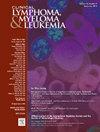Influence of Obesity on the Efficacy and Toxicity of Patients Undergoing Autologous Hematopoietic Cell Transplantation for Lymphoma
IF 2.7
4区 医学
Q2 HEMATOLOGY
引用次数: 0
Abstract
Hematopoietic cell transplantation requires higher doses of chemotherapy, and practices of adjusting the weight because of concerns of organ toxicity are common. This retrospective analysis of 239 adult recipients of autologous hematopoietic cell transplantation for lymphoma assessed the effect of obesity on transplantation outcomes.
Background
Prior data evaluating the impact of obesity in autologous hematopoietic cell transplantation (AHCT) for lymphomas have provided differing results when assessing overall (OS) and progression-free survival (PFS). Impact on survival outcomes have been described, but direct comparison of discrete toxicities is lacking. Patients and methods: We retrospectively compared outcomes with patients divided between 3 groups: nonobese patients (n = 129), obese patients dosed on adjusted body weight (AdjBW) (n = 32), and obese patients dosed on total body weight (TBW) (n = 78).
Results
In multivariate analysis of OS with the nonobese group as the comparator, outcomes trended worse in obese patients dosed on AdjBW (HR 1.22, 95% CI 0.52-2.85) but were improved in obese patients dosed on TBW (HR 0.19, 95% CI 0.04-0.85, P = .012). PFS of obese patients dosed on AdjBW vs. the nonobese group was comparable (HR 1.19, 95% CI 0.63-2.24), but improved in obese patients dosed on TBW (HR 0.45, 95% CI 0.23-0.89, P = .021). Notably, no differences were noted between groups in gastrointestinal, infectious, renal, or hepatic toxicities.
Conclusion
In summary, our data suggest that recipients of AHCT for lymphoma should be dosed on TBW to maximize curative outcomes with no apparent increase in toxicities.

肥胖对淋巴瘤自体造血细胞移植患者疗效和毒性的影响
造血细胞移植需要更高的化疗剂量,因担心器官毒性而调整体重的做法很常见。这项对239名淋巴瘤自体造血细胞移植成年受者的回顾性分析评估了肥胖对移植结果的影响:背景:先前评估肥胖对淋巴瘤自体造血细胞移植(AHCT)影响的数据在评估总生存期(OS)和无进展生存期(PFS)时提供了不同的结果。对生存结果的影响已有描述,但缺乏对离散毒性的直接比较:我们回顾性比较了分为三组的患者的治疗结果:非肥胖患者(n = 129)、按调整体重(AdjBW)用药的肥胖患者(n = 32)和按总重量(TBW)用药的肥胖患者(n = 78):结果:以非肥胖组为对比组进行OS多变量分析,按调整体重(AdjBW)用药的肥胖患者的结果呈恶化趋势(HR 1.22,95% CI 0.52-2.85),但按总体重用药的肥胖患者的结果有所改善(HR 0.19,95% CI 0.04-0.85,P = .012)。使用 AdjBW 的肥胖患者与非肥胖组患者的 PFS 相当(HR 1.19,95% CI 0.63-2.24),但使用 TBW 的肥胖患者的 PFS 有所改善(HR 0.45,95% CI 0.23-0.89,P = .021)。值得注意的是,在胃肠道、感染、肾脏或肝脏毒性方面,组间没有差异:总之,我们的数据表明,淋巴瘤 AHCT 受者的剂量应为 TBW,以便在不明显增加毒性的情况下最大限度地提高治疗效果。
本文章由计算机程序翻译,如有差异,请以英文原文为准。
求助全文
约1分钟内获得全文
求助全文
来源期刊

Clinical Lymphoma, Myeloma & Leukemia
ONCOLOGY-HEMATOLOGY
CiteScore
2.70
自引率
3.70%
发文量
1606
审稿时长
26 days
期刊介绍:
Clinical Lymphoma, Myeloma & Leukemia is a peer-reviewed monthly journal that publishes original articles describing various aspects of clinical and translational research of lymphoma, myeloma and leukemia. Clinical Lymphoma, Myeloma & Leukemia is devoted to articles on detection, diagnosis, prevention, and treatment of lymphoma, myeloma, leukemia and related disorders including macroglobulinemia, amyloidosis, and plasma-cell dyscrasias. The main emphasis is on recent scientific developments in all areas related to lymphoma, myeloma and leukemia. Specific areas of interest include clinical research and mechanistic approaches; drug sensitivity and resistance; gene and antisense therapy; pathology, markers, and prognostic indicators; chemoprevention strategies; multimodality therapy; and integration of various approaches.
 求助内容:
求助内容: 应助结果提醒方式:
应助结果提醒方式:


